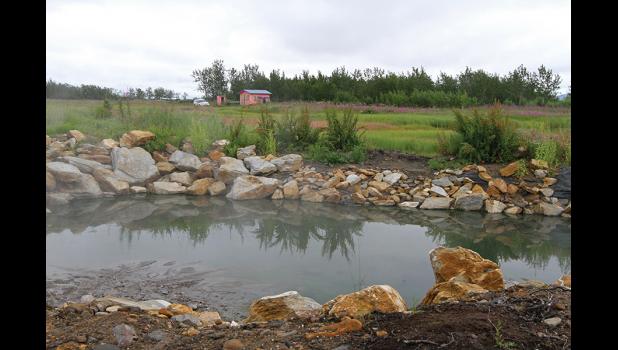Community agriculture planned for Pilgrim Hot Springs
In the last few years, much of the focus to develop Pilgrim Hot Springs was on its potential to provide geothermal energy to Nome, but with those plans not advancing, there are now efforts afoot to look into its potential as an agricultural site as it has been used a hundred years ago.
Recently, Robert Bensin with the Bering Straits Development Corporation, a subsidiary of BSNC, which is part of the consortium Unaatuq LLC that owns Pilgrim, planned to start Community Supported Agriculture, CSA for short.
BSNC is the property manager and onsite project leader, spearheading the effort, Bensin said. The U.S. Dept. of Agriculture National Resources Conservation Service granted $224,000 to conduct a market study and come up with a business plan to sketch out what can be grown at Pilgrim, what the market possibilities are and how those efforts can be accomplished taking into account the remoteness of Pilgrim, located eight miles off the Kougarok Road at mile 65.
According to Bensin, the goal is to develop community-supported agriculture by working with local volunteers. But before any greens can be planted, many things need to be done first.
The first steps to revive agriculture at Pilgrim include clearing one acre at the east field, identifying a fresh water source, setting up irrigation water tanks and clearing lands for cover crops. Also, in order to prevent flooding, there need to be culverts installed and beaver dams removed to allow for water to freely flow during spring breakup. Aerial photos show much of the Pilgrim estate under water due to a blocked culvert underneath the road leading to the site. Bensin said that half of the money needed to get started comes from in-kind donations for labor and resources that are here already. BSNC has materials left over from the failed Rock Creek gold mine that BSNC bought from NovaGold Inc. Large tanks that haven’t been used can be taken to Pilgrim and used for water storage. Chain-link fencing can be used to fence in fields to keep out wild animals, and smaller outbuildings at the mine can be used at the Pilgrim site as tool sheds. Bensin said the endeavor is in the planning stages and that he hopes for regular meetings with interested volunteers to develop realistic ideas. They have consulted with Calypso Farms, a CSA near Fairbanks, and Bethel’s Myers Farm. The concept of a CSA is that community members pay for their crops in advance and also agree to volunteer work. The grand vision is to develop a self-sustaining business model at Pilgrim that would include agriculture and combine it with educational purposes as well as destination travel.
Pilgrim Hot Springs, formerly owned by the Fairbanks Catholic Diocese was sold in 2010 and its new owners are Unaatuq, LLC, a consortium made up of the Bering Straits Native Corporation, Sitnasuak Native Corporation, Kawerak, Inc., Norton Sound Economic Development Corporation, White Mountain Native Corporation, Teller Native Corporation and Mary’s Igloo Native Corporation. According to a Bering Straits press release, the hot springs have been visited for centuries for its curative and spiritual powers, and have tremendous cultural and historical significance for the residents of the region.
Gwen Holdman, director of the Alaska Center for Power and Energy said in an email correspondence with The Nome Nugget that temperatures just 75 ft. below the surface in many places at Pilgrim are close to boiling which means that even in cold winters, the ground is warm and opportunities exist for agriculture that may be unique in the entire state.
“In my mind, Pilgrim Hot Springs has always been a special site,” Holdman wrote. “The site also has a long history of agriculture dating back 100 years — in many ways, we are just trying to recapture knowledge that has been lost, and historic use of this amazing resource.”
Since 2010, ACEP has done a comprehensive resource evaluation funded through Dept. of Energy grants and the Alaska Energy Authority. ACEP’s work culminated in a confirmation well, drilled in 2014. “Overall, we estimate 2MW of power could be generated from this resource under ideal conditions,” Holdman stated. However, plans to develop Pilgrim as a geothermal power source for Nome are stalled. Asked about the agricultural potential, Holdman responded that, at first, an extended seasonal operation would be quite feasible and could be done with a relatively modest budget. “There are some limitations to year-round operation, which would take quite a bit more infrastructure and capital investment to make happen,” Holdman said. “For example, using the geothermal resource for local power and to provide heat to buildings and greenhouses would be fairly crucial to scaling up the operation to year-round. Access to the site in the winter is another challenge. Nonetheless, it has definitely been done —for example, Chena Hot Springs resort operates their greenhouses year round, and uses both geothermal heat and power to do so.”
The upsides of locally grown produce are obvious. It would help the local economy, could provide fresh produce to a region that is depending on imported greens that don’t arrive in Nome so fresh anymore. Holdman reported that the greenhouse at Chena Hot Springs is 60 ft. by 70 ft. in size and can theoretically grow up to 150,000 heads of lettuce a year using hydroponic techniques. “That’s probably a lot more than the region can consume, so even export within a limited niche like lettuce production is not out of the question,” said Holdman.


